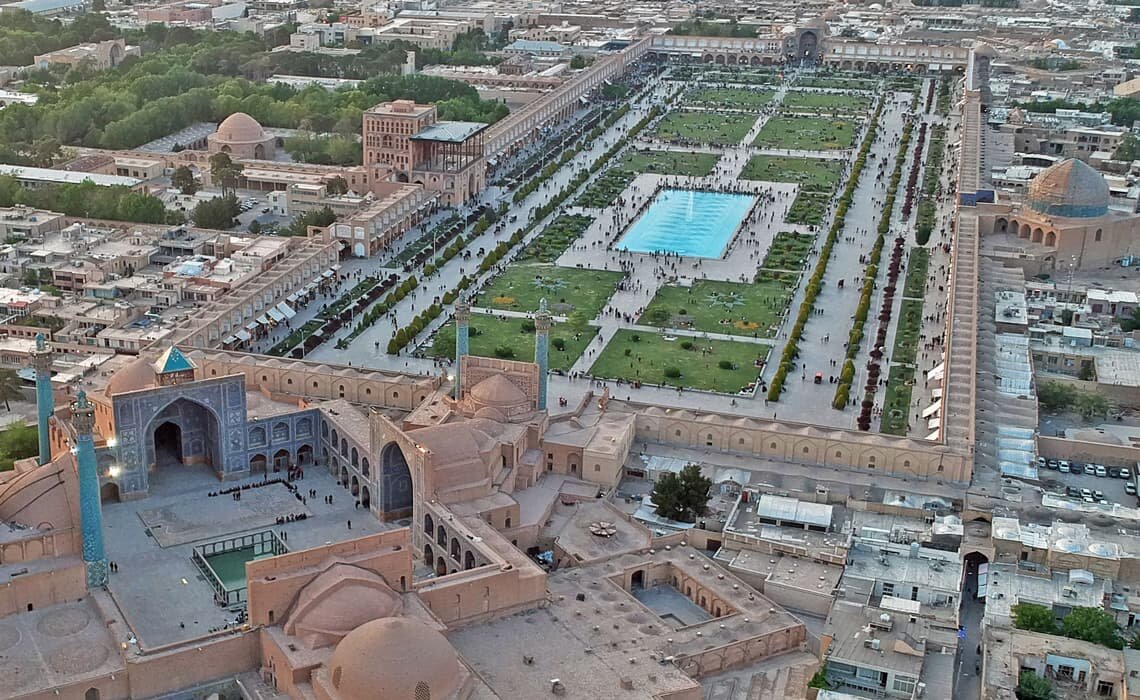Naqsh-e Jahan: a journey through Isfahan’s architectural marvel

TEHRAN – Located in the heart of Isfahan, the ancient city that graces the crossroads of Iran’s north-south and east-west routes, Naqsh-e Jahan is jewel of the Safavid era (1501-1736).
Meanings “Image of the World,” this UNESCO World Heritage site is one of the largest city squares globally and serves as a breathtaking example of Iranian architecture. Its vast expanse and harmonious design invite travelers to embark on a journey through history, culture, and art that transcends time.
Constructed under the visionary order of Shah Abbas I in the early 17th century, Naqsh-e Jahan was the heartbeat of the Safavid Empire.
With dimensions of 560 meters in length and 160 meters in width, the square covers nearly nine hectares, making it a colossal centerpiece of the Safavid capital. It was here that culture, religion, economy, and politics intertwined seamlessly, forming the nucleus of Persian socio-cultural life.
The square’s design embodies a harmonious urban ensemble, with each side graced by four iconic structures, each telling a story of its own: the Sheikh Lotfallah Mosque on the east side; the Ali Qapu Pavilion on the west; the Portico of Qeyssariyeh to the north; and the Royal Mosque (Masjed-e Shah) to the south.
These magnificent edifices, adorned with enameled ceramic tiles and intricate paintings, create a breathtaking panorama that captivates visitors from the moment they step foot onto the square’s sandy esplanade.
Sheikh Lotfallah Mosque
Originally built as a private mosque for the royal court, Sheikh Lotfallah Mosque stands as a symbol of elegance and artistic excellence. The mosque’s dome, adorned with delicate arabesques and a kaleidoscope of colors, seems to change hues with the shifting light of day, leaving visitors spellbound.
Inside, the mosque offers a serene atmosphere where sunlight dances through intricately designed windows, casting ethereal patterns on the walls. This tranquil space invites travelers to experience a moment of spiritual reflection and appreciation for the artistry that flourished under the Safavid dynasty.
Royal Mosque
On the south side of the square, the Royal Mosque, or Masjed-e Shah, rises as a celebrated emblem of Iranian architecture. This iconic structure is angled to face Mecca, a testament to the meticulous planning and spiritual significance embedded in its design. The mosque’s grand entrance and towering minarets command attention, while the intricate tilework and calligraphy adorning its surfaces narrate stories of faith and devotion.
As visitors step into the mosque’s expansive courtyard, they are greeted by the mesmerizing sight of azure blue tiles interwoven with floral motifs, creating an ambiance of serenity and reverence. The Royal Mosque stands as a living testament to the artistic pinnacle achieved during the Safavid era, captivating both art enthusiasts and spiritual seekers alike.
Ali Qapu Palace
The Ali Qapu Palace on the west side of Naqsh-e Jahan Square serves as a majestic entrance to the palatial zone and the royal gardens that stretch beyond.
This monumental edifice was once the hub of royal gatherings, where Shah Abbas I and his courtiers enjoyed music, poetry, and panoramic views of the square below.
The pavilion’s high portal and covered terrace, known as the talar, offer a vantage point from which visitors can gaze upon the bustling activities within the square. Intricate frescoes and elaborate stucco work adorn the interiors, showcasing the fusion of art and architecture that characterized the Safavid period. Standing on the terrace, one can almost hear the echoes of history, where royal decrees were issued and cultural events unfolded.
Qeyssariyeh Bazaar
To the north, the portico of Qeyssariyeh leads to the bustling Isfahan Bazaar, a vibrant vaulted area of commerce and culture that stretches for two kilometers.
The bazaar’s labyrinthine alleys are transported to a world where time seems to stand still. The air is filled with the aroma of exotic spices, the vibrant colors of Persian rugs, and the lively chatter of merchants and shoppers.
Here, artisans continue the age-old traditions of craftsmanship, offering an array of goods ranging from intricate jewelry to handwoven textiles. The bazaar is a testament to Isfahan’s enduring legacy as a center of trade and creativity, inviting visitors to immerse themselves in the vibrant tapestry of Persian life.
Naqsh-e Jahan Square is more than just an architectural marvel. As visitors wander through its grand arcades and explore its iconic landmarks, they are transported to an era where art, spirituality, and social life converged in perfect harmony.
Whether witnessing a polo match on the vast esplanade or savoring the delicate flavors of Persian cuisine in a nearby café, every moment spent at Naqsh-e Jahan is a journey through time, where the past and present intertwine seamlessly.
Naqsh-e Jahan Square is a place where the heart of Isfahan beats strong, inviting travelers to discover the timeless charm of Iran’s cultural gem.
AM
Leave a Comment